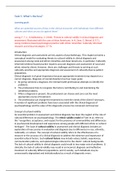Case uitwerking
Task 5. What's the fuss?
- Instelling
- Maastricht University (UM)
GGZ2030. Psychodiagnostics. Taak 5 uitgebreid uitgewerkt: What's the fuss. De aantekeningen vanuit de tutorial zijn bijgeschreven met groen. Voor alle taken, zie de bundel.
[Meer zien]




